Aiming to improve conditions in Palestinian refugee camps: Working together with women, youth, and people with special needs to better their livelihood
2022.02.15
“We always play hide-and-seek and soccer!” Hearing these words of an elementary school student in a Palestinian refugee camp, Japanese pupils smiled and said, “That’s just like us!” An “ORIGAMI* Friendship” event was held last December, bridging Japanese elementary school students and children from Palestinian refugee camps in the West Bank.
* An Origami is a Japanese art of folding paper into decorative shapes and figures.
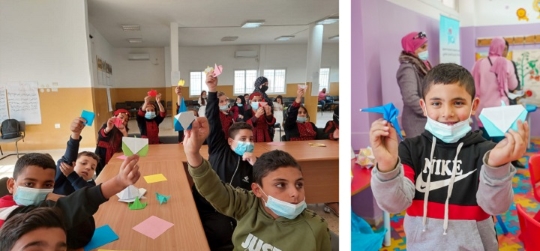
An “ORIGAMI Friendship” for elementary school students in Japan and the three refugee camps in the West Bank, Palestine. JICA is assisting in improving their livelihood
Palestinian children, experiencing origami for the first time, commented with sparkling eyes, “We never thought that folding paper could be so fun!” They added, “We hope everyone in Japan understand that ‘we cannot return to our homeland and we are living under occupation’.” How did these words resonate with children in Japan? The “ORIGAMI Friendship” was picked up on Asahi Shogakusei Shimbun (newspaper for elementary school children).
The people of Palestine have been displaced from their homes for more than 70 years. In the refugee camps dotted around the West Bank and Gaza Strip, economic and social issues are becoming more severe every day. The buildings and facilities are now dilapidated, while unemployment and poverty among the second and third generations of people who were born and raised in these poor conditions are more apparent than ever. JICA, through its efforts to improve the living conditions of Palestinian refugee camps in the West Bank, is supporting the residents so that they can move forward with hope.
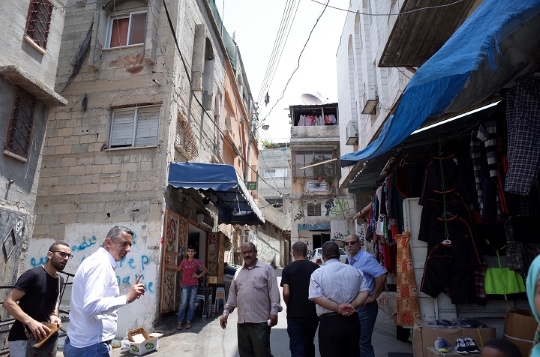
Randomly constructed buildings lining the streets of Nur Shams Refugee Camp
“The issue of Palestinian refugees is one of the most protracted refugee problems in the world since the establishment of the State of Israel in 1948 and the 1947–1949 Palestine war. From the word ‘refugee camp,’ one would imagine a place where people live in temporary tents to escape the ravages of war. However, the number of people living in these temporarily built dwellings has continued to increase, now with the third and fourth generations, and as a result of repeated renovations and expansions, the area is very run-down today. In addition to the aging of buildings, infrastructure such as water, sewage, and electricity has not been maintained enough, and the living and socio-economic conditions continue to deteriorate. It is an urgent issue.”
This overview of the “current state” of refugee camps was given by JICA expert SEKIGUCHI Masaya, working on JICA’s Refugee Camp Improvement Project phase 2 (PALCIP2).
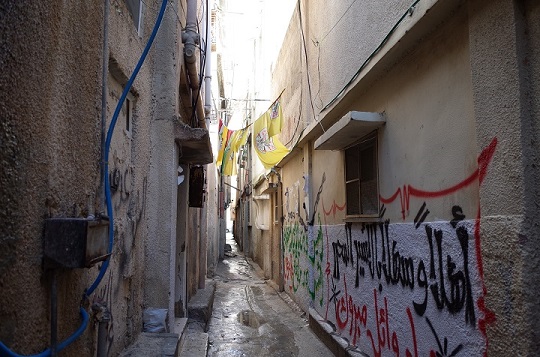
A narrow alleyway in Old Askar Refugee Camp. It is difficult for people to just pass each other
While hoping to one day return to their homeland based on the Right of Return (*1) mentioned in a U.N. General Assembly resolution, a majority of Palestinian refugees are now leaving the refugee camps and purchasing or renting housing in surrounding towns amid stagnant peace negotiations between Israel and Palestine.
“That being said, people who cannot afford to migrate have no choice but to continue living in the refugee camps. The number of refugees in the 19 camps in the West Bank alone is about 260,000(*2). The population is still growing, and there are households with a dozen or more family members living in a space the size of just two small bedrooms. In residential areas, owing to the random construction of houses, numerous narrow alleys exist where it is difficult to even walk past each other. There are many dangerous areas too.”
In response to this situation, JICA, together with the Department of Refugee Affairs (DoRA) of the Palestine Liberation Organization (PLO), launched PALCIP in December 2016, in the three refugee camps of Aqbat Jabr, Old Askar, and Jalazone in the West Bank.
PALCIP promoted the establishment of a system that would allow representatives of all communities, such as women, young people, and people with special needs, to participate in the improvement of the camps. Previously, the management and operation of the camps had been undertaken by a small number of male leaders.
*1 The “Right of Return of the Palestinian People,” as recognized by a U.N. General Assembly resolution.
*2 The United Nations Relief and Works Agency for Palestine Refugees in the Near East (UNRWA) estimates that there are between 2,500 and 27,000 Palestinian refugees in each camp.
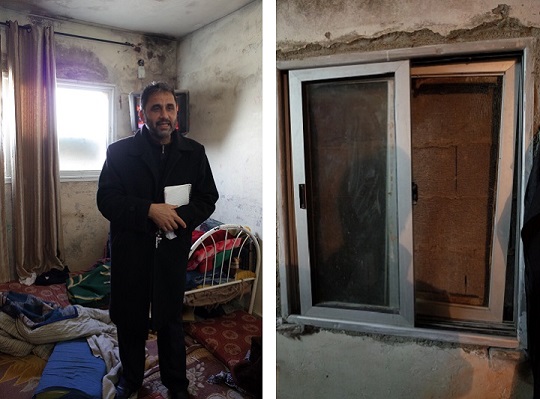
Mr. Yaser Abu Keshek of DoRA, who heads the project, explains the housing situation in Old Askar Refugee Camp
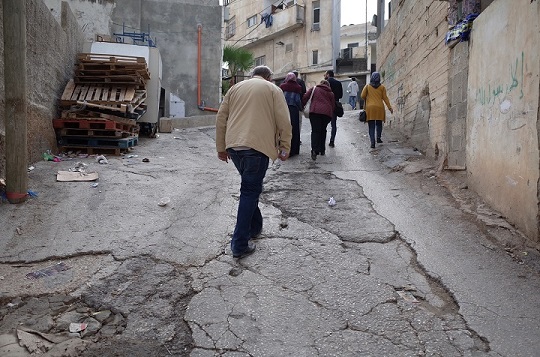
A deteriorated paved road in Jalazone Refugee Camp
In PALCIP, the residents themselves firstly discuss the areas for improvement in the refugee camps, and then the Camp Improvement Forum (CIF), which is made up of representatives selected from various groups among the residents, develops the Camp Improvement Plan (CIP). Through JICA’s technical cooperation, Japanese experts support the smooth implementation of these resident participatory activities, and also assist in the implementation of the proposed improvement plans.
Husam Elayyan, a member of the CIF and director of Jalazone Refugee Camp’s Disabled Centre in the northern part of Ramallah, explains the results of the project as follows. “Up until now, I have been carrying out various activities on my own volition, but participating in the CIF has helped me understand the importance of listening to a wide range of opinions from the people around me. I am now doing this in my activities at the Disabled Centre.”
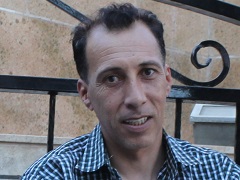
Mr. Husam Elayyan, director of the Disabled Centre, Jalazone Refugee Camp
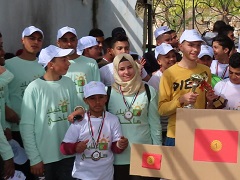
Ms. Madiha Obaid (center) joins a youth activity at Old Askar Refugee Camp
Madiha Obaid, a female CIF member of Old Askar Refugee Camp in the northern Palestine city of Nablus, expressed her motivation, commenting, “Through the activities of the CIF, I realized that I, as a woman, can equally contribute to the community. I felt very happy about that.”
Improvements were made to the infrastructure that is closely related to community life, such as installing wheelchair ramps in refugee camp public halls and outfitting parks with safe playground equipment for children.

(Left) DoRA and CIF members discuss the CIP at Old Askar Refugee Camp
(Right) Public facilities were renovated with universal design at Aqbat Jabr Refugee Camp
Mr. Sekiguchi, who is working on the project, explains that the key terms of the project are “resident participation,” “universal design,” and “inclusiveness,” and looked back on the most memorable events as follows.
“As in Japan, young people in Palestine are not very active in community initiatives. So, on a trial basis, we conducted leadership development activities for them. This led to good communication and built trust between the participating youth and the leaders of the various groups in the refugee camps, and cross-generational collaboration, which had rarely been seen in the past, began to thrive.”
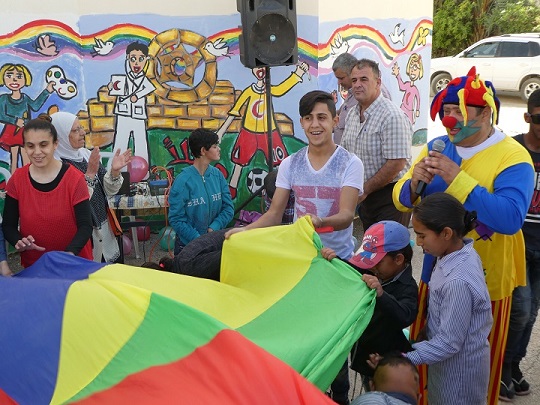
Community activities led by youth in Aqbat Jabr Refugee Camp. All ages are working hard for the sake of the community
Although the impact of COVID-19 has been devastating in Palestine, we launched an initiative with DoRA of the PLO, to further improve the lives of the residents. In Phase 2 of the Refugee Camp Improvement Project (PALCIP2), emergency response measures against the COVID-19 pandemic were implemented in the three refugee camps of Aqbat Jabr, Old Askar, and Jalazone. In addition, the amendment of the CIP, which had been suspended due to COVID-19, was updated. Since last October, Mr. Sekiguchi has resumed his support activities in the field.
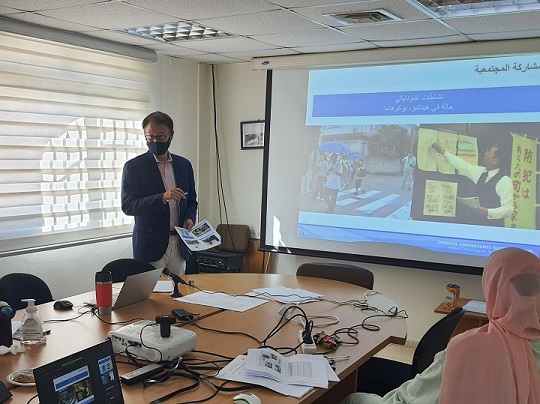
In October last year, Mr. Sekiguchi introduced Japanese community activities to the new DoRA staffs on site
“In PALCIP2, we are experimenting with new fundraising methods such as crowdfunding, apart from the traditional funding. DoRA was skeptical about new methods in the beginning, but in the process of giving them a try, they realized their importance and effectiveness. In the future, we hope to think outside the box and take on challenges together with DoRA and pioneer the future of refugee camps. Some may say, ‘What is the point in making refugee camps comfortable when they are temporary homes?’ However, as the conditions surrounding Palestinian refugees become more and more tough, we feel that it is extremely important to help them to live in safety and dignity. Improving living conditions is a cooperative activity that does not contradict the Right of Return.”
Mr. Sekiguchi, who has been involved in refugee issues for many years, looks forward to the future with strength in his words, as if he were talking to himself.
Since last November, the project has initiated activities in two new refugee camps. Together with DoRA, the project will continue to expand efforts to improve the lives of refugees “with everyone” in as many camps as possible.
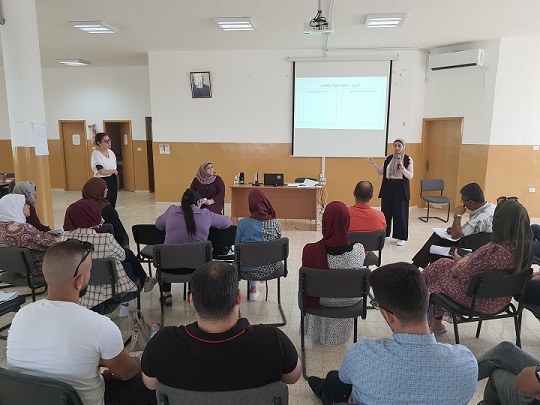
Crowdfunding Training at Aqbat Jabr Refugee Camp, aiming to raise funds for the revised CIP
scroll